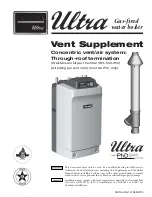
54
PART 6. START-UP PROCEDURES
F. SEQUENCE OF OPERATION
G. 0–10V DIRECT CONTROL
1. When power is first applied to
the control, after an initialization
phase, the control display will read
the temperature Setpoint. The
control will initially run through a
self-diagnostic routine and then go
into its aeration operating mode,
where it bumps the pump on and
off multiple times to purge the
heat exchanger of any air that may
have settled there while the power
is off. If there is no call for heat, the
system will go into an idle state.
NOTE:
The cap on the Automatic
Air Vent (if used), located on top of
the appliance must remain in the
loose state in order for the air to
escape as required.
2. If the thermostat is calling for heat,
the control module will determine
if the water temperature is below
the programmed set point value
minus the switching differential. It
will then initiate a heating cycle.
3. The control then performs
selected system diagnostic
checks. If all checks are
successfully passed, a pre-purge
cycle is initiated (the blower will
be on at 80%).
4. When the pre-purge period is
complete, power is applied to
the spark ignitor for 4.5 seconds.
Approximately 1/2 second later,
flame is verified. If a flame is
not verified during the trial-
for-ignition, the gas valve is
immediately closed and the
control will return to Step 3. After
four trials, if a flame is not verified,
the control will go into a lockout
mode. If a flame is confirmed, the
control enters the heating mode.
The firing rate will be based on the
control’s proprietary algorithm.
5. When water temperature
reaches the temperature set
point value, the burner will be
at minimum firing rate.If,when
firing at minimum rate, it reaches
temperature setpoint plus offset,
the gas valve closes and the
control enters a post-purge state
(the blower will be on at 80%). At
any time if an external thermostat
is being used and becomes
satisfied, the gas valve will be
closed immediately.
6. When the post-purge is complete,
the control enters an idle state
while continuing to monitor
temperature and the state of other
system devices. If a call-for-heat
is received, the control will
automatically return to Step 2 in
sequence and repeat the entire
operating cycle.
7. Built in freeze protection: all models
will automatically turn the pump on
if the heat exchanger
reaches 41°F and the burner if it
reaches 37°F, it will turn off at 50°F.
NOTE:
Power must be left on for
this protection to function.
During the idle state and heat state,
if the control detects an improper
operating state from external
devices, such as the high-limit
switch, the control will illuminate an
error code in the display.
WATER TEMPERATURE OVER 125ºF CAN CAUSE SEVERE BURNS INSTANTLY, OR
DEATH FROM SCALDS. CHILDREN, THE DISABLED, AND THE ELDERLY ARE AT
HIGHEST RISK OF BEING SCALDED. SEE INSTRUCTION MANUAL BEFORE SETTING
TEMPERATURE AT WATER HEATER. FEEL WATER BEFORE BATHING OR SHOWERING!
TEMPERATURE LIMITING VALVES ARE AVAILABLE.
DANGER
Direct Control
In the situation where direct control
of the appliance is desired (such
as from a Building Management
System), the appliance can be
programmed to receive a 0–10 volt
DC signal to control operation.
Note:
This operation is only possible
in individually-controlled units (i.e.:
not Cascaded) and when each is
individually vented.
There are two variations of this kind
of external control (see Parameter
S-18): Load Control and Set Point
Control. In Load Control, the voltage
signal controls the burner firing rate.
In Set Point Control, the voltage
signal controls the temperature set
point of the appliance. (This is similar
to how the appliance is controlled
when operating without an outside
signal.)
Setting up Direct Control
There are three steps required to
set up this mode of operation. First,
connect the incoming voltage signal
to pins
5 and 6?
on the terminal strip.
Next, remove the jumper from
the remote thermostat terminals
(pins
11 and 12?
If this is not done,
the appliance will fire based on its
internal set point when the voltage
drops below 1.0VDC. If the appliance
Содержание XL800
Страница 6: ...6 PART 1 GENERAL INFORMATION As a Stand Alone Appliance HOT CONTROL MENU NAVIGATION ...
Страница 7: ...7 PART 1 GENERAL INFORMATION Appliance as Part of a Cascade HOT CONTROL MENU NAVIGATION ...
Страница 19: ...19 PART 2 ELECTRICAL B INTERNAL WIRING CONNECTION continued XL BCB LAYOUT ...
Страница 21: ...21 PART 2 ELECTRICAL XL CASCADE BOX ...
Страница 31: ...31 PART 4 VENTING Direct Vent Terminal Clearances ...
Страница 32: ...32 PART 4 VENTING Direct Vent Terminal Clearances continued Other Than Direct Vent Terminal Clearances ...
Страница 33: ...33 PART 4 VENTING Other Than Direct Vent Terminal Clearances continued ...
Страница 69: ...69 PART 10 PARTS BREAKDOWN 1A 1B PART 10 PARTS BREAKDOWN 2 ...
Страница 70: ...70 PART 10 PARTS BREAKDOWN 3 4 5 6 7 8 9A 9B 9C 10 4 ...
















































